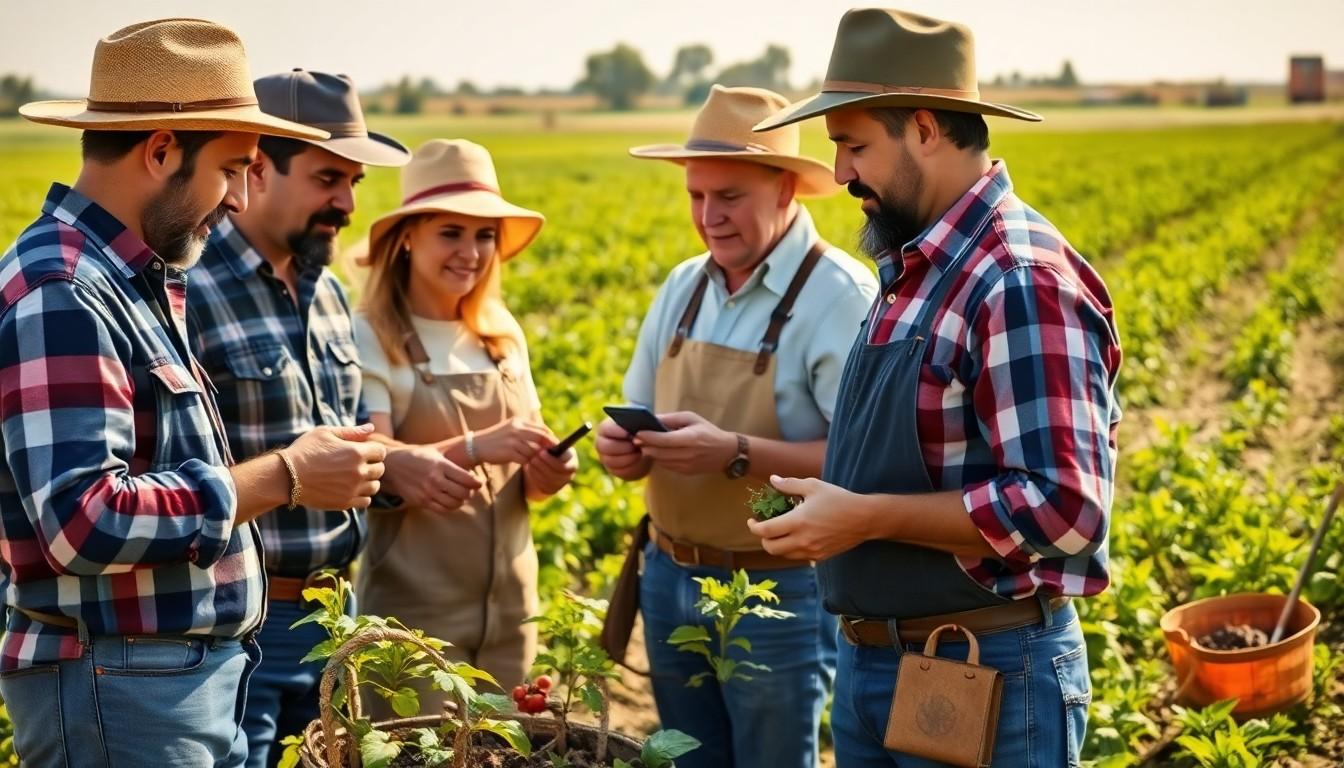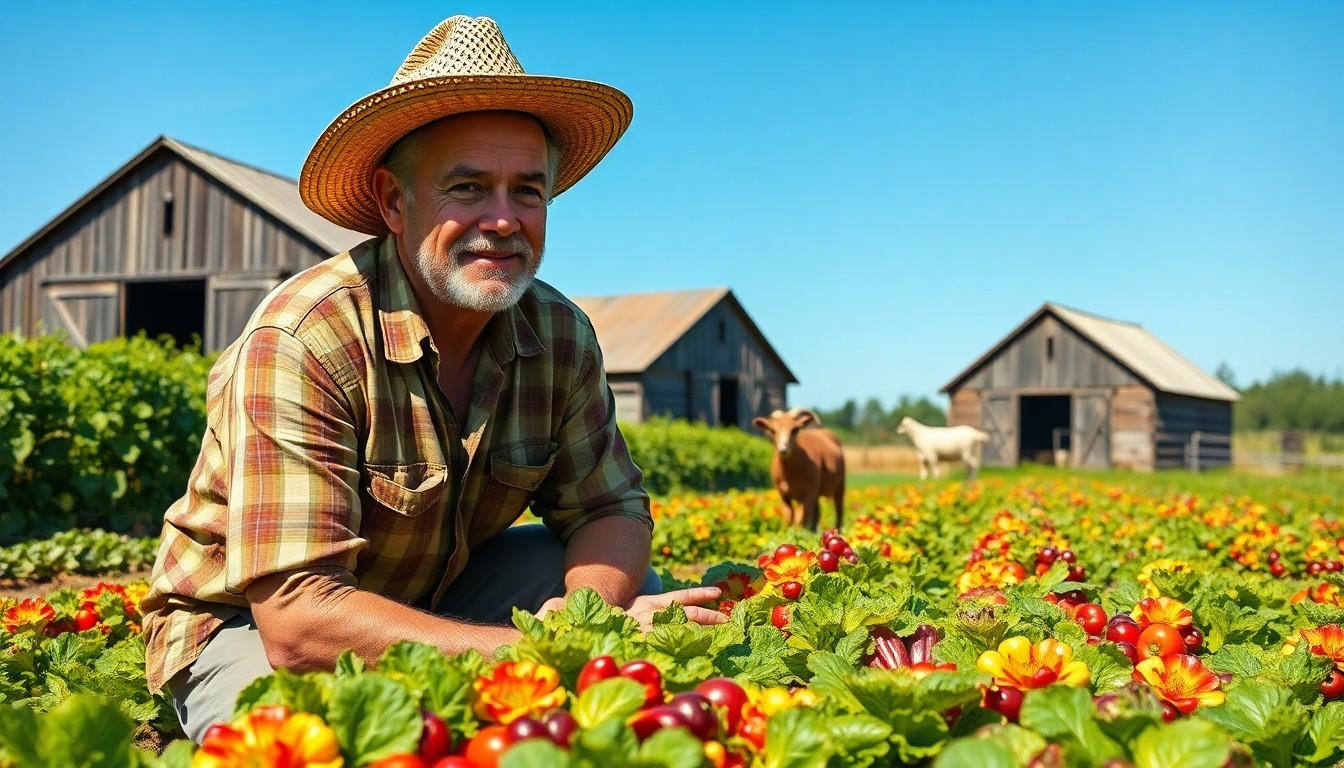In a world where “organic” has become the buzzword of the century, starting an organic farm might just be the most rewarding adventure one can embark on. Imagine trading in that 9-to-5 grind for a life filled with fresh air, vibrant crops, and maybe even a goat or two. Yes, you read that right—goats. They’re not just for Instagram; they can be great farm companions!
How to Start Organic Farming
Organic farming focuses on growing crops and raising livestock without synthetic chemicals or genetically modified organisms. Farmers emphasize natural processes, sustainable practices, and environmental stewardship to produce healthy food.
Definition of Organic Farming
Organic farming refers to agricultural methods that prioritize ecological balance and biodiversity. It prohibits synthetic fertilizers and pesticides, relying instead on natural solutions such as compost and crop rotation. Additionally, organic farming promotes soil health through techniques like cover cropping and agroforestry. Certification bodies, such as the USDA, set strict guidelines to ensure products meet organic standards.
Importance of Organic Farming
Organic farming plays a crucial role in environmental sustainability. By avoiding harmful chemicals, it reduces soil and water pollution, benefiting ecosystems and wildlife. This approach also enhances soil fertility, which leads to more resilient crops. In terms of human health, organic produce contains higher levels of antioxidants and fewer pesticide residues. Farmers benefit from direct-to-consumer sales, often yielding higher profits than conventional farming methods.
Getting Started with Organic Farming

Starting organic farming involves careful planning and an understanding of the land and resources available. Identifying specific goals helps streamline efforts toward a successful farming venture.
Assessing Your Land and Resources
Evaluating the land includes analyzing soil quality, drainage, and sunlight exposure. Testing soil properties through a lab can provide insights into nutrient content and pH levels. Identifying available water sources ensures proper irrigation for crops. Considering space for crops and livestock allows effective layout planning. Understanding local climate conditions helps determine what can thrive in a given area. Gathering necessary tools and equipment will also support farming tasks.
Choosing the Right Crops
Selecting suitable crops requires awareness of climate and soil conditions. Researching native plants can reveal varieties that naturally adapt to local environments. Considering market demand ensures profitable sales opportunities. Picking diverse crops can enhance soil health and reduce pest infestations. Setting up a planting schedule maximizes growth potential and yields. Exploring companion planting can optimize space and promote healthier crops.
Essential Practices for Organic Farming
Successful organic farming relies on various essential practices. Implementing these foundational techniques leads to sustainable and productive results.
Soil Health and Management
Soil health drives the success of organic farming. Testing soil properties for nutrients and pH levels ensures crop suitability. Incorporating organic matter, such as compost, enhances soil structure and fertility. Crop rotation maintains balanced nutrient levels while reducing pest buildup. Farmers should also practice minimal tillage to preserve soil organisms. Adopting cover crops prevents erosion and suppresses weeds. Regularly assessing soil moisture aids in irrigation management, ensuring water efficiency.
Pest and Disease Control
Effective pest and disease control safeguards organic crops. Understanding crop rotation helps disrupt pest life cycles. Natural predators, like ladybugs and lacewings, provide biological control without chemicals. Planting a diverse range of species reduces the risk of widespread infestations. Implementing integrated pest management utilizes multiple techniques for better results. Monitoring pest populations regularly aids in timely interventions. Organic-approved treatments, such as neem oil or insecticidal soap, help manage outbreaks effectively.
Certification and Regulations
Organic farming involves specific certification processes and regulations that ensure compliance with established standards. Understanding these guidelines is crucial for farmers aiming to enter the organic market.
Understanding Organic Certification
Certification verifies that farmers follow organic practices. USDA oversees this process, requiring compliance with the National Organic Program (NOP) standards. Initial steps involve submitting an application to a USDA-accredited certifying agent. A comprehensive plan outlining farming practices must also be provided. Typically, a three-year transition period helps farmers adjust their methods to meet organic standards. During this time, fields cannot use prohibited substances, ensuring the integrity of organic produce.
Key Regulations to Follow
Farmers must adhere to several regulations when pursuing organic farming. Maintaining detailed records is essential for tracking inputs and practices used on the farm. Crop rotation helps prevent disease and pest build-up, aligning with organic principles. Moreover, using only approved substances for pest and weed management is mandatory. Engaging with local agricultural agencies can provide additional support and insights into complying with state-specific regulations, enhancing overall success in organic farming. Following these regulations sustains the quality and reputation of organic products in the marketplace.
Marketing Your Organic Produce
Effective marketing of organic produce plays a crucial role in achieving business success. Farmers must understand their audience and develop strategies to reach potential customers.
Identifying Your Target Market
Identifying the target market begins with understanding customer preferences. Younger consumers often seek out organic options for health and environmental reasons. Local community members appreciate fresh, locally sourced produce. Grocery stores and farmers’ markets serve as great avenues for selling organic products. Food co-ops and restaurants that prioritize sustainable sourcing also represent viable options. Research shows that connecting with health-conscious individuals leads to better sales opportunities.
Effective Marketing Strategies
Effective marketing strategies enhance the visibility of organic products. Utilizing social media platforms helps engage consumers, showcasing crops and sharing farming practices. Farmers can participate in local farmers’ markets to build relationships with the community. Collaborating with local restaurants or grocery stores can introduce organic produce to larger audiences. Creating a website to share information about products, prices, and availability attracts more customers. Offering farm tours or workshops increases customer interaction and loyalty. Carefully crafted advertisements highlighting the benefits of organic farming appeal to potential buyers.
Growth and Connection to Nature
Starting an organic farm is an exciting journey that combines passion for the land with a commitment to sustainability. By embracing natural farming methods and focusing on soil health, growers can cultivate not only crops but also a thriving ecosystem.
With careful planning and a clear understanding of local conditions, aspiring farmers can select the right crops and implement effective pest management strategies. Engaging with the community through direct sales and innovative marketing can further enhance the success of an organic venture.
As this rewarding lifestyle gains popularity, the potential for both personal fulfillment and environmental impact becomes increasingly significant. The path to organic farming is paved with opportunities for growth and connection to nature.

